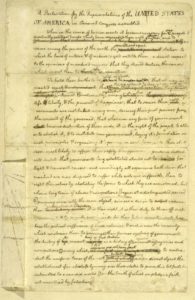
Even the Declaration of Independence needed some edits before it was published (public domain image)
We all need editors. Even Founding Fathers like Thomas Jefferson.
In 1776, delegates met in Philadelphia to debate and decide whether to declare the 13 colonies they represented as being independent of Great Britain.
Jefferson, who was from Virginia, was charged to lead a group in writing a Declaration of Independence. The committee included John Adams of Massachusetts, Benjamin Franklin of Pennsylvania, Robert Livingstone of New York, and Roger Sherman of Connecticut.
As the image shows, the authors didn’t get it right on the first try. They followed the same practices that writers must follow today, such as:
- Preparing a draft.
- Reviewing the draft.
- Marking up the draft.
- Reviewing the draft with the extended team—in this case, the other delegates.
- Debating and deciding what changes were to be incorporated or left out, and why.
Then, of course, they had to get the signoff from the other delegates. It was a big deal; they were pledging their lives, their fortunes, and their sacred honor to this declaration.
John Hancock’s signature, of course, was the largest. But it had the signatures of some other prominent Americans (Franklin) and two future presidents (Adams and Jefferson).
We all know what happened next. Today, Americans celebrate the 241st anniversary of the Declaration of Independence.
And to think it might not have come about had it not been for careful writing, editing, feedback, and buy-in.
Happy Independence Day.
